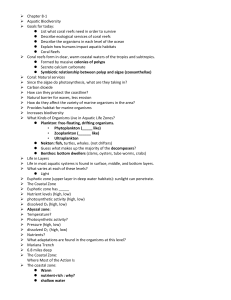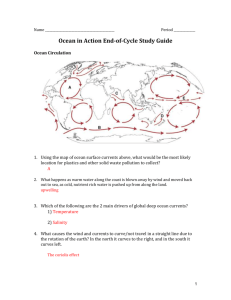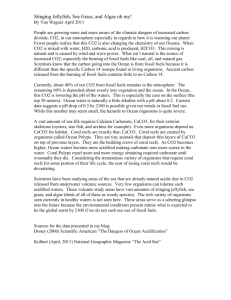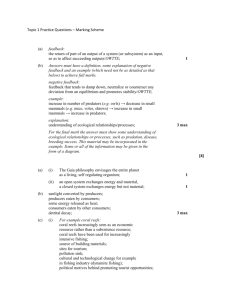Ocean Exam Study Guide Key
advertisement
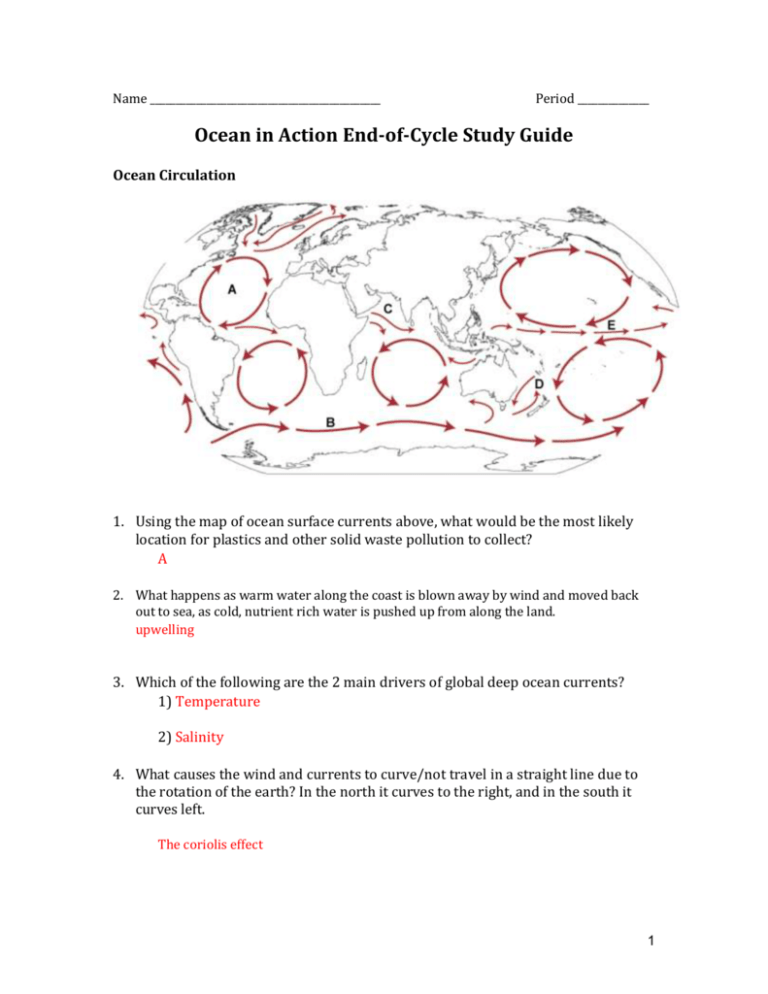
Name _____________________________________________ Period ______________ Ocean in Action End-of-Cycle Study Guide Ocean Circulation 1. Using the map of ocean surface currents above, what would be the most likely location for plastics and other solid waste pollution to collect? A 2. What happens as warm water along the coast is blown away by wind and moved back out to sea, as cold, nutrient rich water is pushed up from along the land. upwelling 3. Which of the following are the 2 main drivers of global deep ocean currents? 1) Temperature 2) Salinity 4. What causes the wind and currents to curve/not travel in a straight line due to the rotation of the earth? In the north it curves to the right, and in the south it curves left. The coriolis effect 1 5. What is the temperature and direction of the California Current, which flows along the west coast of North America? Temperature Cold Direction south 6. How would a colder Scandanavia and Great Britain affect the thermohaline circulation of currents? (increase it, decrease it, cause it to shut down). Shut it down 7. During an El Niño-Southern Oscillation (ENSO) event, which of the following best describes conditions in the eastern part of the tropical Pacific Ocean (e.g., near Peru and Ecuador)? What happens to the high and low pressure areas in the eastern and western Pacific? The high ad low pressure areas are switched, so that the normal cold upwelling along the coast of the South America (Eastern Pacific) is replaced with higher sea surface temperatures and higher precipitation levels. 2 Fisheries and Aquaculture 8. Give four results of salmon farming (aquaculture). 1. Environmental stress to salmon after their release 2. Resource competition between farmed and wild salmon 3. Increased susceptibility to diseases due to genetic uniformity 4. Pollution of surrounding ocean with waste and excess feed 9. How is bottom trawling is detrimental to benthic organisms? A boat drags a large net across the bottom of the ocean floor, destroying habitats, stirring up sedimentation, reducing spawning grounds, and catching unwanted bycatch. 10. Why has the maximum sustainable yield for ocean fisheries has been exceeded? (what happens annually? Refer to your Tragedy of the commons activity) Too many marine fish of reproductive age are harvested annually 11. What is an economic approach to reduce overfishing/what could government eliminate for fisherman? Eliminating subsidies 12. Which of the following laws was implemented in the US to govern the conservation and management of ocean fisheries? Magnuson Fishery Conservation and Management Act 13. One of the world’s largest exporters of shrimp is Thailand, where coastal mangrove swamps are often destroyed to make room for shrimp farms. What are 4 ecological impacts of the destruction of mangrove forests for this type of aquaculture? 1. Exposes the surrounding shorelines to coastal erosion 2. Opens coastal areas to severe damage from storms and hurricanes 3. Reduces biodiversity in important spawning and nursery areas 4. May increase spread of diseases to wild populations of shrimp Aquatic Biomes 14. Which part of the ocean would a marine biologist studying areas of high biodiversity be most likely to conduct research in? 3 Coral reefs in the neritic zone, above the continental shelf 15. Why are sharks are at the top of the food chain and their removal would have far-reaching consequences for the entire ecosystem. What is the term to describe an organism that would cause such a drastic change to the ecosystem, if it were removed? Keystone species 16. Which of the following terms best describes an area where salt and freshwater mix that has a very high level of productivity? (3% salt water or brackish water exists here) An estuary 17. Put the following aquatic biomes into the following catagories of salinity: River, Lake, Esturary, Coral Reefs (Coastal Marine Ecosystem), Deep ocean Marine Ecosystem. Oligotrophic (0.5-5 psu) Mesotrophic (5-18psu) Polytrophic (18-30 psu) Estuary Coral Reefs River Deep Ocean Marine Lake Ecosystem 18. Wetlands surrounding a river, provide what ecosystem services? 1) Prevention of Flooding 2) remediation of toxic chemicals and excess nutrients 19. What does phytoplankton (the most abundant primary producer in the world) produce through photosynthesis in the ocean? 1) dissolved oxygen 2) glucose 20. The ecosystems with the world’s highest net primary productivity (NPP) per unit area are located in which part of the ocean? Euphotic zone 4 Water Pollution 21. In a river ecosystem, dissolved oxygen concentrations drop quickly downstream from a point-source input of organic matter into the river. What is this effect most likely due to? Increasing bacterial activity due to decay of organic matter [Source: http://mdk12.org/instruction/clg/public_release/biology/G3_E5_I2.html] 22. Which organism in the food web above would be most likely to accumulate the highest concentration of a fat-soluble pollutant? The Killer whale because of biomagnification, in which toxic pollutants are not broken down, and travel up the food chain, accumulating at the top. 23. In what way does the Great Pacific Garbage Patch represent a “tragedy of the commons”? Pacific Rim countries are polluting the water in a way that affects the quality of the ocean for all, but no one is accountable for it. 24. Which of the following is the most common cause of cultural eutrophication in surface waters? 5 Runoff of nitrate into bodies of water 25. How does logging/ deforestation lead to non-point source pollution? Logging and deforestation leads to sedimentation, which lowers water quality. It is not easily identifiable, and therefore is considered a non-point source of pollution. 26. When we did our toxicity lab, we found that worm (we used black worms) tend to be very tolerant of pollution, and resistant to high toxicity levels. Explain why the presence of black worms or sludge worms and anaerobic bacteria are indicators of polluted water. Sludge worms and anaerobic bacteria 27. What is the number 1 source of oil pollution in the ocean? (surprisingly) Storm water runoff from land 28. What are three of the most common methods employed to clean up oil spills? Large floating booms, skimmer boats, and chemical dispersants 29. Name 3 point sources of pollution. 1) Factory effluent (emissions and discharge) 2) A specific active or inactive mine 3) Sewage Treatment plant 30. A marine scientist suspects that runoff from nearby farms is creating a hypoxic zone (area of low oxygen content) in a coastal area. Which of the following water quality tests would be best suited to determining whether the area is actually hypoxic? Dissolved oxygen 31. Environmental conditions in coastal estuaries vary hourly and seasonally. What are TWO important causes for the variation in the temperature and/or salinity of an estuary. Be sure to include the connection between each cause and temperature and/or salinity. 1) The tides, which are controlled by the moon bring more salinic water into the estuary at different points in the day, and in different variations depending on the time of the month and year (tilt of the earth’s axis). 6 2) Vertical mixing by the natural ebb and flow of waves causes the waters of various densities to circulate and mix. Meanwhile if there is little movement, the freshwater or warm water will float to the top where it can be blown away by the wind, allowing for cold, salinic upwelling. 32. What are 2 reasons that wetlands are ecologically important? 1) They provide a habitat for various wildlife. 2) They are usually very biodiverse and provide spawning grounds for fish and birds. 3) They provide nutrient cycling, or soak up excess nutrients. 33. What are 2 reasons that wetlands are economically important? 1) They provide phytoremediation, through plants that soak up toxic chemicals 2) They provide a location for fishing, canoeing, hiking, and other sources of recreation 3) they reduce flooding and erosion 34. Explain THREE ways in which humans have had a negative impact on or have degraded coastal wetlands. 1) They have removed wetlands for agricultural purposes or to develop urban areas. 2) They have over used groundwater which causes salt water intrusion and reduces the balance of the ecosystem. 3) They have polluted the waters, harvested the plants and hunted the birds. 4) They have attempted to use wetlands like esturaries for aquaculture, which can lead to other wildlife getting caught in nets, excess nutrients/nitrogen produced, escaped species, increased disease, and a decrease in genetic stability and health of organisms and the ecosystem. 35. What are 2 pieces of legislation that could reduce the negative impacts that humans have on the wetlands, and explain using the provisions of each act how they might prevent/reduce wetland degradation. 1) Magnueson Fisheries conservation and management Act 2) Marine Mammal Act 7 3) Endangered species Act 4) National Environmental Protection Act 5) Clean water Act (look them up in your environmental policy notes to see what they do) 36. Excess carbon dioxide (CO2 ) dissolved in the ocean (due to increased pollution) could affect pH. pH is the amount of H+ that can be donated. Write the chemical equation, that explains why excess CO2 may increase the acidity of the ocean? CO2 + HOH H2CO3 (carbonic acid) which further dissociates in water donating hydrogen ions. Carbon dioxide and water form carbonic acid, which makes the water more acidic, therefore decreasing the pH of the water. 37. Coral reefs are produced when corals acquire calcium ions (Ca2+) and carbonate ions (CO32-) from seawater and deposit solid CaCO3 to form their exoskeletons. How might coral reefs be affected by excess CO2? There would an access of H2CO3 formed from the Carbon dioxide, reducing the CaCO3 formed or the amount of coral formed, because there is less CO3 ions available in the water, as more will be used initially to form carbonic acid. As a result of ocean acidification, it is expected that in 2050 the mass of CaCO3 deposited will be 20% less than it is currently if pH remains at its current value. 1.5 x 1012 x (2x10-1) = 3x1011 kg CaCO3 8 38. Look at the chart above. Explain 2 reasons why the movement of carbon into the ocean has been increasing since 1850, as a result of CO2 production by humans. As CO2 increases, it reacts with water to form H2CO3 which is the acidic. Acids are compounds that donate hydrogen protons (H+). H2CO3 donates 2 H+ as it dissociates in the sea water, so it decreases the pH of the water. The lower the pH, the more acidic the solution. In order to model the effects of ocean acidification on coral reefs, some simplifying assumptions can be made. Use the assumptions in the table below to perform the calculations that follow. Assume that the total global area of corals growing in reefs is 2.5 x 1011m2 Assume that corals grow only vertically and that the average vertical growth rate of corals is 3 mm/year. Assume that the average density of CaCO3 in corals is 2 x 103 kg/m3. (i) Calculate the current annual global increase in volume, in m3 per year, of CaCO3 in coral reefs. Show all steps in your calculation. Step 1: What is the total global area (m2) of coral reefs? 2.5 x 1011m2 Step 2: convert mm to m, to determine the vertical m/year. 3 mm/yr x 1m/1000mm=.003 m/yr 9 In scientific notation 3x10-3 m/year Step 3: What is the volume (m3) per year CaCO3? (Volume= area times vertical height) (ii) (2.5x1011)(3x10-3) = 7.5 x108 m3/year Calculate the current annual global increase in mass, in kg, of CaCO3 in coral reefs. Show all steps in your calculation. Step 1: What is the annual global volume increase that you calculated in part (i)? Step 2: What is the density of CaCO3 in kg/m3? Step 3: Using the formula for density (D=m/v) what is the increase in global mass in kg of CaCO3 in coral reefs? 7.5x108 m3/year 2 x 103 kg/m3. (2 x 103 kg/m3)=m/(7.5x108 m3/year) m=(2 x 103 kg/m3) (7.5x108 m3/year) m=15x1011=1.5x1012 kg (iii) Because of ocean acidification, it is expected that in 2050 the mass of CaCO3 deposited annually in coral reefs will be 20 percent less than is deposited currently. Calculate how much less CaCO3, in kg, is expected to be deposited in 2050 than would be deposited if ocean water pH were to remain at its current value. Step 1: What is the annual global increase in mass in kg of CaCO3 in coral reefs? (from part ii) Step 2: find 20% of that mass using multiplication. 1.5x1012 kg (1.5x1012)(.2) = 0.3x1012kg=3x1011 kg 39. Give 4 reasons why destroying coral reefs would be harmful to the environment, 10 and why? Impact Loss of Habitat Loss of biodiversity of species diversity/richness Decreased protection of coastal areas from wave/storm surges Loss of carbon sink Why elimination of food source for marine life loss of breeding grounds for fish and bird species loss of shelter – hiding places decrease in the number, variety, or distribution of species Decrease in populations of species/reduction in gene pool destruction of coastal habitats accelerated erosion of shoreline habitats less carbon storage in coral reefs 40. What are 3 environmental problems (other than one due to ocean acidification or loss of coral reefs) that humans cause and affect marine ecosystems on a global scale? 1) over fishing, destructive fishing practices 2) thermal pollution (increased ocean temperature) 3) Introduction of Invasive species 4) Eutrophication: nutrient pollution leads to Hypoxia/Dead Zones 5) Garbage/Plastic debris 6) Oil Spills/Off shore oil drilling 7) Mercury Pollution 8) Pesticide Pollution 11 12
